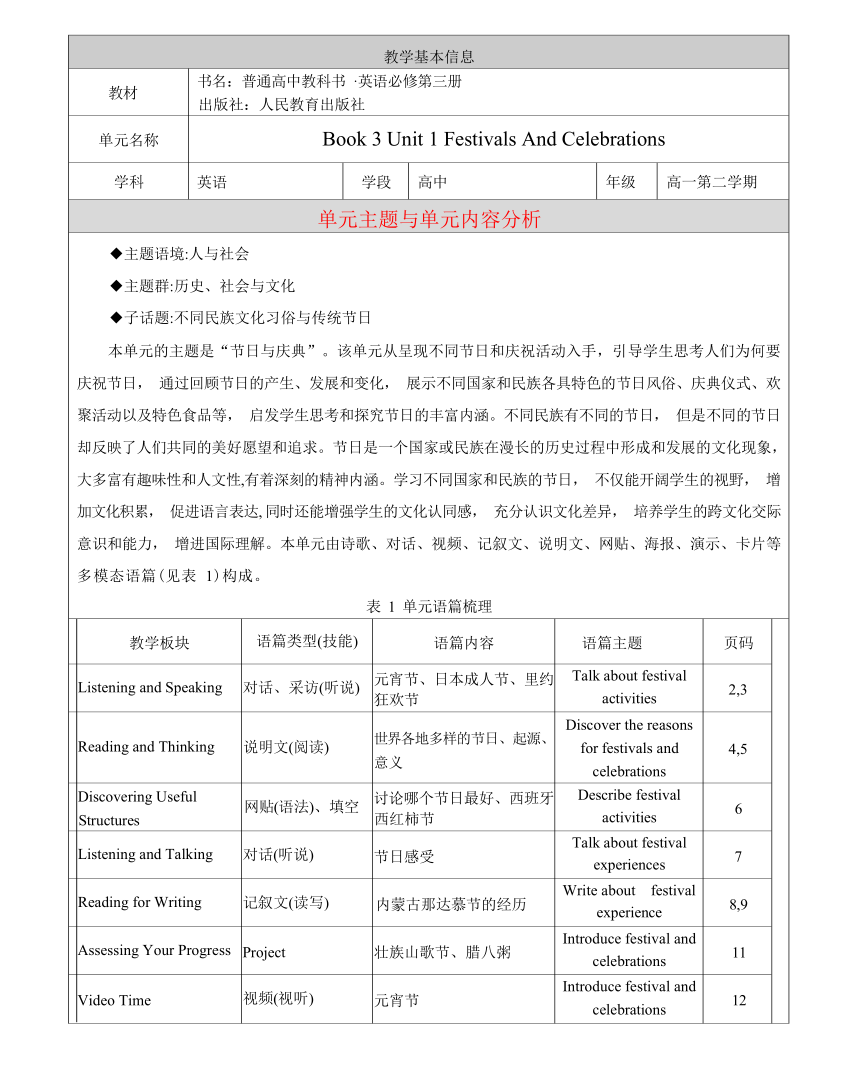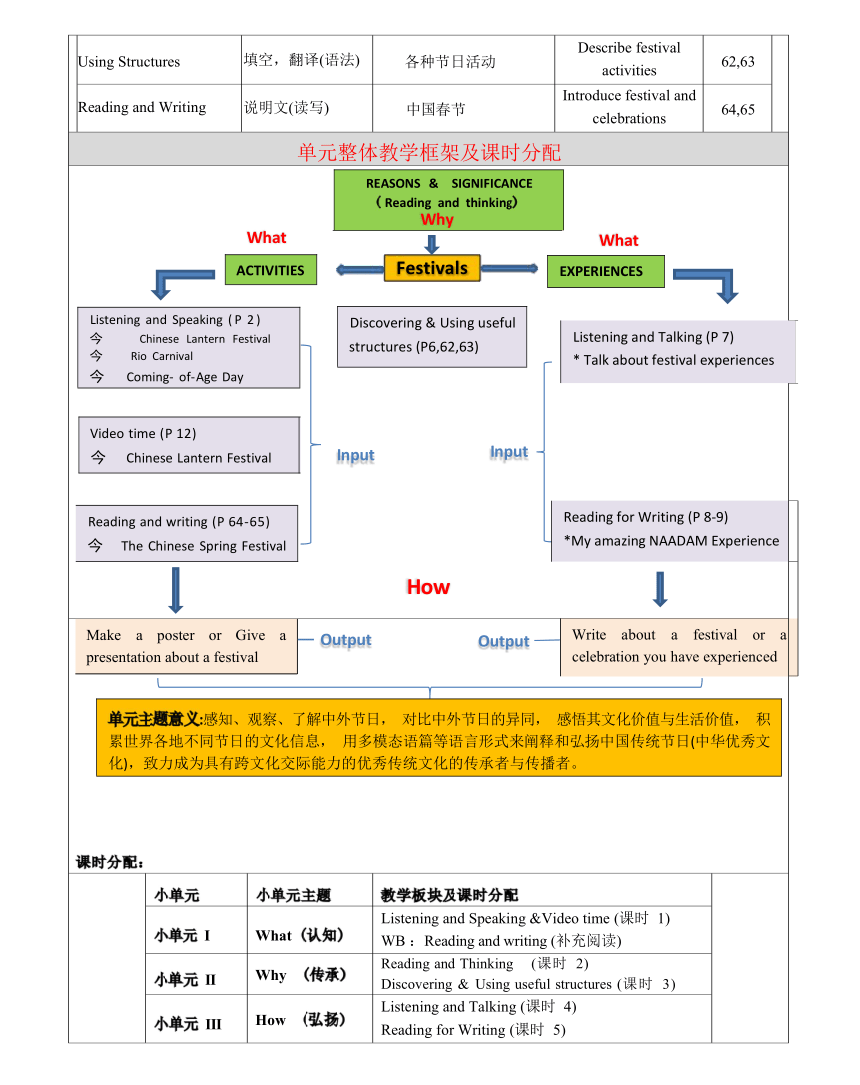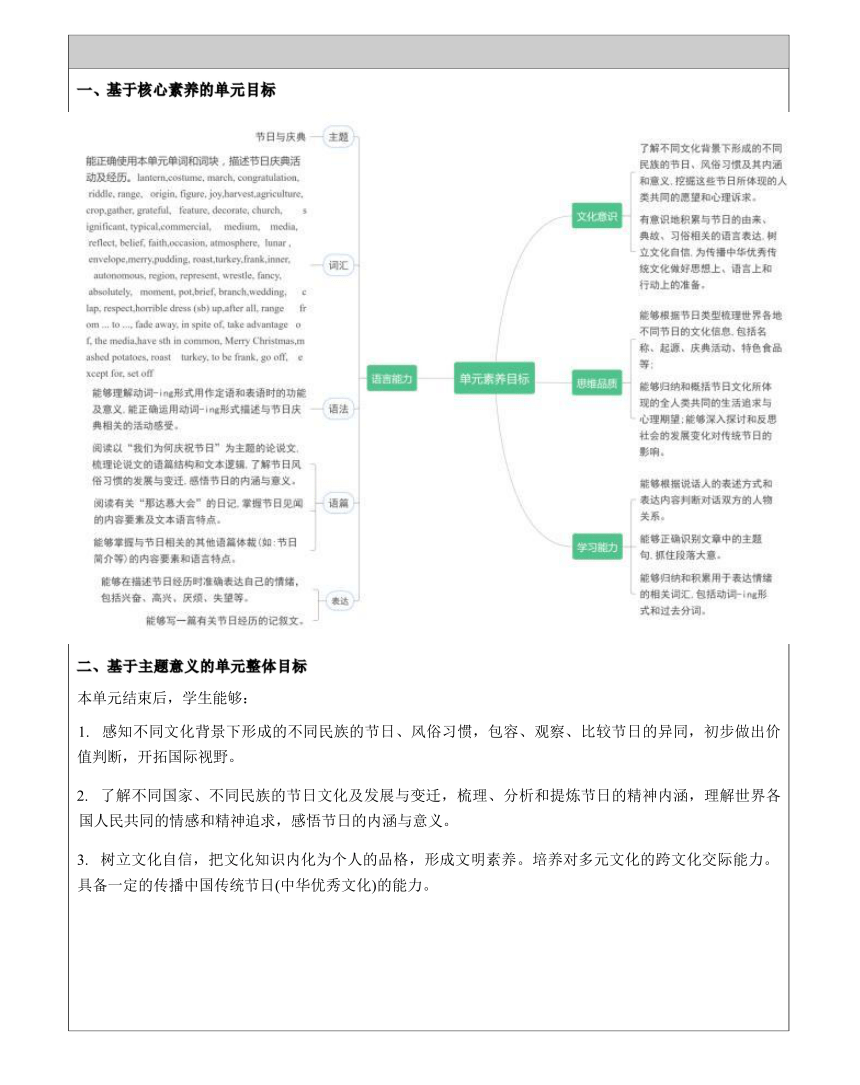人教版(2019)必修 第三册 UNIT 1 FESTIVALS AND CELEBRATIONS 单元整体设计(表格式)
文档属性
| 名称 | 人教版(2019)必修 第三册 UNIT 1 FESTIVALS AND CELEBRATIONS 单元整体设计(表格式) |  | |
| 格式 | docx | ||
| 文件大小 | 113.7KB | ||
| 资源类型 | 教案 | ||
| 版本资源 | 人教版(2019) | ||
| 科目 | 英语 | ||
| 更新时间 | 2023-07-22 16:23:10 | ||
图片预览



文档简介
教学基本信息
教材 书名:普通高中教科书 ·英语必修第三册 出版社:人民教育出版社
单元名称 Book 3 Unit 1 Festivals And Celebrations
学科 英语 学段 高中 年级 高一第二学期
单元主题与单元内容分析
◆主题语境:人与社会 ◆主题群:历史、社会与文化 ◆子话题:不同民族文化习俗与传统节日 本单元的主题是“节日与庆典”。该单元从呈现不同节日和庆祝活动入手,引导学生思考人们为何要 庆祝节日, 通过回顾节日的产生、发展和变化, 展示不同国家和民族各具特色的节日风俗、庆典仪式、欢 聚活动以及特色食品等, 启发学生思考和探究节日的丰富内涵。不同民族有不同的节日, 但是不同的节日 却反映了人们共同的美好愿望和追求。节日是一个国家或民族在漫长的历史过程中形成和发展的文化现象, 大多富有趣味性和人文性,有着深刻的精神内涵。学习不同国家和民族的节日, 不仅能开阔学生的视野, 增 加文化积累, 促进语言表达, 同时还能增强学生的文化认同感, 充分认识文化差异, 培养学生的跨文化交际 意识和能力, 增进国际理解。本单元由诗歌、对话、视频、记叙文、说明文、网贴、海报、演示、卡片等 多模态语篇(见表 1)构成。 表 1 单元语篇梳理
教学板块 语篇类型(技能) 语篇内容 语篇主题 页码
Listening and Speaking 对话、采访(听说) 元宵节、日本成人节、里约 狂欢节 Talk about festival activities 2,3
Reading and Thinking 说明文(阅读) 世界各地多样的节日、起源、 意义 Discover the reasons for festivals and celebrations 4,5
Discovering Useful Structures 网贴(语法)、填空 讨论哪个节日最好、西班牙 西红柿节 Describe festival activities 6
Listening and Talking 对话(听说) 节日感受 Talk about festival experiences 7
Reading for Writing 记叙文(读写) 内蒙古那达慕节的经历 Write about festival experience 8,9
Assessing Your Progress Project 壮族山歌节、腊八粥 Introduce festival and celebrations 11
Video Time 视频(视听) 元宵节 Introduce festival and celebrations 12
Using Structures 填空,翻译(语法) 各种节日活动 Describe festival activities 62,63
Reading and Writing 说明文(读写) 中国春节 Introduce festival and celebrations 64,65
单元整体教学框架及课时分配
(
W
hat
) ACTIVITIES
Listening and Speaking (P 2) 今 Chinese Lantern Festival 今 Rio Carnival 今 Coming- of-Age Day
(
Video
time
(
P
12)
今
Chinese
Lantern
Festival
) (
Reading
and
writing
(
P
64-65)
今
The
Chinese
Spring
Festival
) (
Listeni
ng
and
Talking
(
P
7)
*
Talk
about
fes
tival
experiences
) (
I
nput
) (
REASONS
&
SIGNIFICANCE
(
Reading
and
thinking
)
W
hy
) (
W
hat
) (
EXPE
RIENCES
)Festivals Discovering & Using useful structures (P6,62,63)
(
I
nput
) (
Reading
fo
r
Writing
(
P
8-9)
*My
amazing
NAAD
AM
Experience
) (
H
ow
)
(
Make
a
poster
or
Give
a
presentation
about
a
festival
Outp
ut
) (
a
festival
or
a
have
experienced
Writ
e
about
celebra
tion
you
Outp
ut
) (
单元主
题
意义
:
感知、观察、了解中外节日,
对比中外节日的异同,
感悟其文化价值与生活价值,
积
累
世界各地不同节日的文化信息,
用多模态语篇等语言形式来阐释和弘扬中国传统节日
(
中华优秀文
化
)
,致力成为
具有跨文化交际能力的优秀传统文化的传承者与传播者。
) 课时分配:
小单元 小单元主题 教学板块及课时分配
小单元 I What (认知) Listening and Speaking &Video time (课时 1) WB :Reading and writing (补充阅读)
小单元 II Why (传承) Reading and Thinking (课时 2) Discovering & Using useful structures (课时 3)
小单元 III How (弘扬) Listening and Talking (课时 4) Reading for Writing (课时 5)
单元整体教学目标及课时目标
一、基于核心素养的单元目标 二、基于主题意义的单元整体目标 本单元结束后,学生能够: 1. 感知不同文化背景下形成的不同民族的节日、风俗习惯,包容、观察、比较节日的异同,初步做出价 值判断,开拓国际视野。 2. 了解不同国家、不同民族的节日文化及发展与变迁,梳理、分析和提炼节日的精神内涵,理解世界各 国人民共同的情感和精神追求,感悟节日的内涵与意义。 3. 树立文化自信,把文化知识内化为个人的品格,形成文明素养。培养对多元文化的跨文化交际能力。 具备一定的传播中国传统节日(中华优秀文化)的能力。
本单元整体教学目标与各课时教学目标,及其之间的联系
小单元 单元目标 课时分配 板块 课时目标
小单元 I (What) 感知不同文化背景下 形成的不同民族的节 日、风俗习惯,包容、 观察、比较节日的异同 初步做出价值判断, 开 拓国际视野。 第 1 课时 Listening and Speaking &Video time 感知语篇中介绍的三个不同节日, 分析比较异同 点,并能以对话形式来阐述观点和原因。
小单元 II (Why) 了解不同国家、不同民 族的节日文化及发展 与变迁, 梳理、分析和 提炼节日的精神内涵, 理解世界各国人民共 同的情感和精神追求, 感悟节日的内涵与意 义。 第 2 课时 Reading and Thinking 感知和对比世界各地不同节日的起源、作用和地 位,分析归纳不同节日的功能和目的, 感悟其物 质诉求和精神诉求, 形成跨文化敏感性、文明素 养和正确的节日(文化)观。
第 3 课时 Discovering Useful Structures 能够理解动词-ing 形式用作定语和表语时的功 能及意义,能正确运用动词-ing 形式描述与节日 庆典相关的活动感受。
小单元 III (How) 树立文化自信, 把文化 知识内化为个人的品 格,形成文明素养。培 养对多元文化的跨文 化交际能力。具备一定 的传播中国传统节日 (中华优秀文化)的能力 第 4 课时 Listening and Talking 根据图片和所列问题预测对话内容, 准确获取对 话中的细节信息;围绕个人节日经历展开交流, 并在交谈中合理运用表达情感的句式。
第 5 课时 Reading for Writing 通过阅读和学习这篇日记, 了解我国蒙古族“那 达慕大会”这一传统节日,感受蒙古族人民的性 格特色、娱乐精神及其浓厚的文化氛围,学会欣 赏和珍惜多姿多彩的民族文化。掌握节日见闻的 内容要素及文本语言特点,写一篇记叙文,介绍 自己的一次节日经历。
单元整体提升 单元总结提升, 巩固语言知识, 完成主题项目活 动。掌握节日简介的内容要素和语言特点, 通过 报告、海报、展示和微视频等形式介绍一个节日 或庆典。
单元教学评一体化一览表
教学目标 课时 教学活动 评价内容
感知不同文化 背景下形成的 不同民族的节 日、风俗习惯, 包容、观察、 比较节日的异 同,初步做出 价值判断,开 拓国际视野。 第 1 课时 Listening and Speaking &Video time Activity 1 Brainstorm festivals at home and abroad Activity 2 Listen about the three festivals 1.Choose some words or phrases from the box to describe each festival. 2.Listen and write the order of the conversations next to the names of the festivals. 3.Listen for relationships. Match each conversation with the relationship between the speakers below. 4.Listen and View for activities 1.学生能够列举出三个节日的 庆祝活动。 2.学生能够结合已有背景知识, 运用话题词汇来描述节日活动。 3.学生能够批判性地思考庆祝 节日的方式。
Activity 3 Speaking Which of these festivals do you like best Activity 4 Discussion How to celebrate festivals in a civilized and way. proper 了解不同国家 不同民族的节 日文化及发展 与变迁,梳理、 分析和提炼节 日的精神内涵 理解世界各国 人民共同的情 感和精神追求 感悟节日的内 涵与意义。 第2&3 课时 Reading and Thinking & Discovering Useful StructuresStep I Lead-in 1.What festivals do you celebrate with your family each year 2. What are the traditional activities of celebrating these three festivals 3. Why do we celebrate different festivals Step II Fast reading Underline the topic sentence of each paragraph that gives the main idea , and draw the mind-map the main structure of the passage. Step III Careful reading 1.Read the second paragraph and describe the harvest festivals around the world. 2.Read the third paragraph. How do you feel about festival customs that have already faded away 3.Read the fourth paragraph and answer the question. What is the writer's attitude towards the commercialisation of festivals 4.Read the first paragraph and the last paragraph to answer the questions. 1) What do most festivals seem to have in common 2)Why do you think people around the world find these things important Step IV Critical thinking More and more young people are crazy about western festivals. When western festivals come, they usually go to restaurants or shopping malls to have fun. What do you think of this kind of phenomenon? Step V Creative thinking Create a new virtual festival with your group as you wish, make a mind map of it and then present it to the whole class . Step VI Discovering and Using useful Structures --ving form 1. 学生能够熟悉段落中心句 的位置,在找出每段中心句的 基础上,理清文章脉络,判断 文章结构; 2. 学生能够梳理、分析和提炼 节日的精神内涵,理解各国人 民的共同情感和精神追求。 3.学生能够批判性地发表对节 日习俗消亡和商业化现象的看 法。 4.学生能够树立传统节日的保 护意识,弘扬民族自信。 5.学生能够发挥想象创造新节 日,迁移运用本课时关于节日 的知识。 6.能够理解动词-ing 形式用作 定语和表语时的功能及意义,能 正确运用动词-ing 形式描述与 节日庆典相关的活动感受。
树立文化自信 把文化知识内 化为个人的品 格,形成文明 素养。培养对 多元文化的跨 文化交际能力 具备一定的传 播中国传统节 日(中华优秀 文化)的能力 第 4 课时 Listening and Talking Before Listening: Predictions While Listening : 1.Listen to the conversation and answer the questions. 1) What did Max do during the festival 2) What dishes did Max’s mother cook 3) What did Max and his family do during and after the dinner 4) What was the best part of the festival 2. Listen again and tick the phrases that Max or Song Lin uses. (Expressing feelings and emotions) After Listening :Talking (Share a recent festival experience with the partner.) 1.学生能够根据图片和所列问 题预测对话内容、准确获取对 话中的细节信息; 2.学生能够围绕个人节日经历 展开交流,并在交谈中合理运 用表达情感的句式。
第 5 课时 Reading for Writing Step 1. Review Step 2. Warm up Step 3. Read for Basic Information Step 4.Read for structure Step 5. Read for Language Features Q1: In what order did the author write the diary And how do you know that Q2 :What activities did the author experience Q3 :What’re the author’s feelings during and after the festival Step 6. Writing Use what you have learnt to write about a festival or a celebration you have experienced recently. Step 7. Present and Evaluate 1.学生能够掌握节日相关关键 信息和篇章结构、语言特色等 相关信息; 2.学生能够根据阅读文章所获 取的信息,写出结构清晰、内 容详实的节日经历记叙文。
单元整体提升 Step 1. Vocabulary 1. 学生能够熟练掌握, 并准确
Step 2. Useful Structures Step 3 Project运用单元主题词汇和语法结构 2.学生能够通过报告、海报、展 示和微视频等形式介绍一个中 国节日或庆典, 弘扬中国文化, 增强爱国热情。
教材 书名:普通高中教科书 ·英语必修第三册 出版社:人民教育出版社
单元名称 Book 3 Unit 1 Festivals And Celebrations
学科 英语 学段 高中 年级 高一第二学期
单元主题与单元内容分析
◆主题语境:人与社会 ◆主题群:历史、社会与文化 ◆子话题:不同民族文化习俗与传统节日 本单元的主题是“节日与庆典”。该单元从呈现不同节日和庆祝活动入手,引导学生思考人们为何要 庆祝节日, 通过回顾节日的产生、发展和变化, 展示不同国家和民族各具特色的节日风俗、庆典仪式、欢 聚活动以及特色食品等, 启发学生思考和探究节日的丰富内涵。不同民族有不同的节日, 但是不同的节日 却反映了人们共同的美好愿望和追求。节日是一个国家或民族在漫长的历史过程中形成和发展的文化现象, 大多富有趣味性和人文性,有着深刻的精神内涵。学习不同国家和民族的节日, 不仅能开阔学生的视野, 增 加文化积累, 促进语言表达, 同时还能增强学生的文化认同感, 充分认识文化差异, 培养学生的跨文化交际 意识和能力, 增进国际理解。本单元由诗歌、对话、视频、记叙文、说明文、网贴、海报、演示、卡片等 多模态语篇(见表 1)构成。 表 1 单元语篇梳理
教学板块 语篇类型(技能) 语篇内容 语篇主题 页码
Listening and Speaking 对话、采访(听说) 元宵节、日本成人节、里约 狂欢节 Talk about festival activities 2,3
Reading and Thinking 说明文(阅读) 世界各地多样的节日、起源、 意义 Discover the reasons for festivals and celebrations 4,5
Discovering Useful Structures 网贴(语法)、填空 讨论哪个节日最好、西班牙 西红柿节 Describe festival activities 6
Listening and Talking 对话(听说) 节日感受 Talk about festival experiences 7
Reading for Writing 记叙文(读写) 内蒙古那达慕节的经历 Write about festival experience 8,9
Assessing Your Progress Project 壮族山歌节、腊八粥 Introduce festival and celebrations 11
Video Time 视频(视听) 元宵节 Introduce festival and celebrations 12
Using Structures 填空,翻译(语法) 各种节日活动 Describe festival activities 62,63
Reading and Writing 说明文(读写) 中国春节 Introduce festival and celebrations 64,65
单元整体教学框架及课时分配
(
W
hat
) ACTIVITIES
Listening and Speaking (P 2) 今 Chinese Lantern Festival 今 Rio Carnival 今 Coming- of-Age Day
(
Video
time
(
P
12)
今
Chinese
Lantern
Festival
) (
Reading
and
writing
(
P
64-65)
今
The
Chinese
Spring
Festival
) (
Listeni
ng
and
Talking
(
P
7)
*
Talk
about
fes
tival
experiences
) (
I
nput
) (
REASONS
&
SIGNIFICANCE
(
Reading
and
thinking
)
W
hy
) (
W
hat
) (
EXPE
RIENCES
)Festivals Discovering & Using useful structures (P6,62,63)
(
I
nput
) (
Reading
fo
r
Writing
(
P
8-9)
*My
amazing
NAAD
AM
Experience
) (
H
ow
)
(
Make
a
poster
or
Give
a
presentation
about
a
festival
Outp
ut
) (
a
festival
or
a
have
experienced
Writ
e
about
celebra
tion
you
Outp
ut
) (
单元主
题
意义
:
感知、观察、了解中外节日,
对比中外节日的异同,
感悟其文化价值与生活价值,
积
累
世界各地不同节日的文化信息,
用多模态语篇等语言形式来阐释和弘扬中国传统节日
(
中华优秀文
化
)
,致力成为
具有跨文化交际能力的优秀传统文化的传承者与传播者。
) 课时分配:
小单元 小单元主题 教学板块及课时分配
小单元 I What (认知) Listening and Speaking &Video time (课时 1) WB :Reading and writing (补充阅读)
小单元 II Why (传承) Reading and Thinking (课时 2) Discovering & Using useful structures (课时 3)
小单元 III How (弘扬) Listening and Talking (课时 4) Reading for Writing (课时 5)
单元整体教学目标及课时目标
一、基于核心素养的单元目标 二、基于主题意义的单元整体目标 本单元结束后,学生能够: 1. 感知不同文化背景下形成的不同民族的节日、风俗习惯,包容、观察、比较节日的异同,初步做出价 值判断,开拓国际视野。 2. 了解不同国家、不同民族的节日文化及发展与变迁,梳理、分析和提炼节日的精神内涵,理解世界各 国人民共同的情感和精神追求,感悟节日的内涵与意义。 3. 树立文化自信,把文化知识内化为个人的品格,形成文明素养。培养对多元文化的跨文化交际能力。 具备一定的传播中国传统节日(中华优秀文化)的能力。
本单元整体教学目标与各课时教学目标,及其之间的联系
小单元 单元目标 课时分配 板块 课时目标
小单元 I (What) 感知不同文化背景下 形成的不同民族的节 日、风俗习惯,包容、 观察、比较节日的异同 初步做出价值判断, 开 拓国际视野。 第 1 课时 Listening and Speaking &Video time 感知语篇中介绍的三个不同节日, 分析比较异同 点,并能以对话形式来阐述观点和原因。
小单元 II (Why) 了解不同国家、不同民 族的节日文化及发展 与变迁, 梳理、分析和 提炼节日的精神内涵, 理解世界各国人民共 同的情感和精神追求, 感悟节日的内涵与意 义。 第 2 课时 Reading and Thinking 感知和对比世界各地不同节日的起源、作用和地 位,分析归纳不同节日的功能和目的, 感悟其物 质诉求和精神诉求, 形成跨文化敏感性、文明素 养和正确的节日(文化)观。
第 3 课时 Discovering Useful Structures 能够理解动词-ing 形式用作定语和表语时的功 能及意义,能正确运用动词-ing 形式描述与节日 庆典相关的活动感受。
小单元 III (How) 树立文化自信, 把文化 知识内化为个人的品 格,形成文明素养。培 养对多元文化的跨文 化交际能力。具备一定 的传播中国传统节日 (中华优秀文化)的能力 第 4 课时 Listening and Talking 根据图片和所列问题预测对话内容, 准确获取对 话中的细节信息;围绕个人节日经历展开交流, 并在交谈中合理运用表达情感的句式。
第 5 课时 Reading for Writing 通过阅读和学习这篇日记, 了解我国蒙古族“那 达慕大会”这一传统节日,感受蒙古族人民的性 格特色、娱乐精神及其浓厚的文化氛围,学会欣 赏和珍惜多姿多彩的民族文化。掌握节日见闻的 内容要素及文本语言特点,写一篇记叙文,介绍 自己的一次节日经历。
单元整体提升 单元总结提升, 巩固语言知识, 完成主题项目活 动。掌握节日简介的内容要素和语言特点, 通过 报告、海报、展示和微视频等形式介绍一个节日 或庆典。
单元教学评一体化一览表
教学目标 课时 教学活动 评价内容
感知不同文化 背景下形成的 不同民族的节 日、风俗习惯, 包容、观察、 比较节日的异 同,初步做出 价值判断,开 拓国际视野。 第 1 课时 Listening and Speaking &Video time Activity 1 Brainstorm festivals at home and abroad Activity 2 Listen about the three festivals 1.Choose some words or phrases from the box to describe each festival. 2.Listen and write the order of the conversations next to the names of the festivals. 3.Listen for relationships. Match each conversation with the relationship between the speakers below. 4.Listen and View for activities 1.学生能够列举出三个节日的 庆祝活动。 2.学生能够结合已有背景知识, 运用话题词汇来描述节日活动。 3.学生能够批判性地思考庆祝 节日的方式。
Activity 3 Speaking Which of these festivals do you like best Activity 4 Discussion How to celebrate festivals in a civilized and way. proper 了解不同国家 不同民族的节 日文化及发展 与变迁,梳理、 分析和提炼节 日的精神内涵 理解世界各国 人民共同的情 感和精神追求 感悟节日的内 涵与意义。 第2&3 课时 Reading and Thinking & Discovering Useful StructuresStep I Lead-in 1.What festivals do you celebrate with your family each year 2. What are the traditional activities of celebrating these three festivals 3. Why do we celebrate different festivals Step II Fast reading Underline the topic sentence of each paragraph that gives the main idea , and draw the mind-map the main structure of the passage. Step III Careful reading 1.Read the second paragraph and describe the harvest festivals around the world. 2.Read the third paragraph. How do you feel about festival customs that have already faded away 3.Read the fourth paragraph and answer the question. What is the writer's attitude towards the commercialisation of festivals 4.Read the first paragraph and the last paragraph to answer the questions. 1) What do most festivals seem to have in common 2)Why do you think people around the world find these things important Step IV Critical thinking More and more young people are crazy about western festivals. When western festivals come, they usually go to restaurants or shopping malls to have fun. What do you think of this kind of phenomenon? Step V Creative thinking Create a new virtual festival with your group as you wish, make a mind map of it and then present it to the whole class . Step VI Discovering and Using useful Structures --ving form 1. 学生能够熟悉段落中心句 的位置,在找出每段中心句的 基础上,理清文章脉络,判断 文章结构; 2. 学生能够梳理、分析和提炼 节日的精神内涵,理解各国人 民的共同情感和精神追求。 3.学生能够批判性地发表对节 日习俗消亡和商业化现象的看 法。 4.学生能够树立传统节日的保 护意识,弘扬民族自信。 5.学生能够发挥想象创造新节 日,迁移运用本课时关于节日 的知识。 6.能够理解动词-ing 形式用作 定语和表语时的功能及意义,能 正确运用动词-ing 形式描述与 节日庆典相关的活动感受。
树立文化自信 把文化知识内 化为个人的品 格,形成文明 素养。培养对 多元文化的跨 文化交际能力 具备一定的传 播中国传统节 日(中华优秀 文化)的能力 第 4 课时 Listening and Talking Before Listening: Predictions While Listening : 1.Listen to the conversation and answer the questions. 1) What did Max do during the festival 2) What dishes did Max’s mother cook 3) What did Max and his family do during and after the dinner 4) What was the best part of the festival 2. Listen again and tick the phrases that Max or Song Lin uses. (Expressing feelings and emotions) After Listening :Talking (Share a recent festival experience with the partner.) 1.学生能够根据图片和所列问 题预测对话内容、准确获取对 话中的细节信息; 2.学生能够围绕个人节日经历 展开交流,并在交谈中合理运 用表达情感的句式。
第 5 课时 Reading for Writing Step 1. Review Step 2. Warm up Step 3. Read for Basic Information Step 4.Read for structure Step 5. Read for Language Features Q1: In what order did the author write the diary And how do you know that Q2 :What activities did the author experience Q3 :What’re the author’s feelings during and after the festival Step 6. Writing Use what you have learnt to write about a festival or a celebration you have experienced recently. Step 7. Present and Evaluate 1.学生能够掌握节日相关关键 信息和篇章结构、语言特色等 相关信息; 2.学生能够根据阅读文章所获 取的信息,写出结构清晰、内 容详实的节日经历记叙文。
单元整体提升 Step 1. Vocabulary 1. 学生能够熟练掌握, 并准确
Step 2. Useful Structures Step 3 Project运用单元主题词汇和语法结构 2.学生能够通过报告、海报、展 示和微视频等形式介绍一个中 国节日或庆典, 弘扬中国文化, 增强爱国热情。
